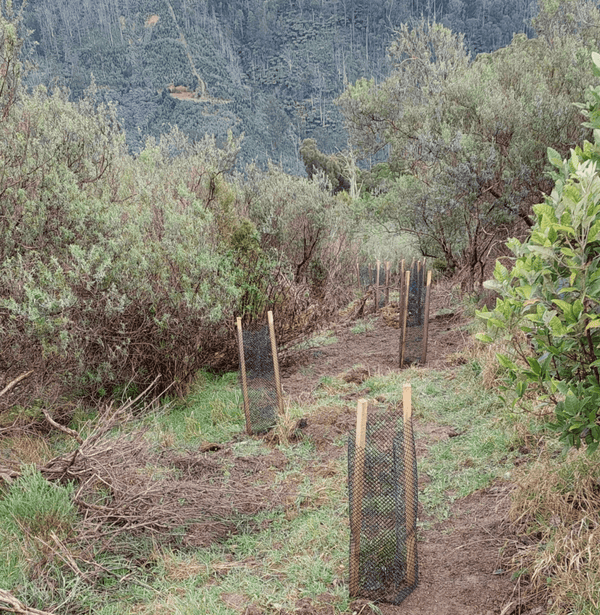Located on the lands of the Kurnai people in Gippsland, Victoria, Greenfleet’s project at Jumbuk will provide habitat for a variety of local wildlife. It will link with the Morwell National Park and Strzelecki State Forest to allow wildlife to move safely through the region.
Previously used for farming and pine, Jumbuk was purchased by owners Nathaniel and Nicole Howse in 2016. With the goal to return the property to its pre-cleared state, they partnered with Greenfleet to restore a legally protected forest across the site.

“We won't be around in 99 years but knowing the certainty of survival of this young forest with Greenfleet's help and expertise has created the outcome we always hoped for. For anyone wanting to rehabilitate their land for conservation purposes, we would definitely recommend contacting Greenfleet.“ - Nathaniel and Nicole Howse
This project will deliver climate action by removing carbon from the atmosphere, while helping bolster existing native ecosystems on the site.

Location & Map
Jumbuk is located in Gippsland, on the lands of the Kurnai people, a 30-minute drive south of Morwell. Covering 17 hectares, this forest sits within a region renowned for its highly productive land and carbon sequestration potential.
This forest builds on Greenfleet’s extensive work in the Gippsland region, you can see where many of Greenfleet’s projects are growing here.

Revegetation Approach & Species Selection
Greenfleet is planting locally native species to help restore the ecosystem which previously existed at Jumbuk. Tree species that will grow tall and help establish the forest canopy were planting including such as silver wattle (Acacia dealbata), blackwood (Acacia melanoxylon) and messmate stringybark (Eucalyptus obliqua), all of which can grow to over 20 metres tall.
The surrounding area is populated with pine plantations, which negatively impacts native wildlife. This makes our reforestation work at Jumbuk vital for extending the remnant forest found on site and restoring the natural ecosystem for the benefit of the native wildlife.

Eleven different locally native tree and plant species have been restored at Jumbuk across 2023 and 2024. The seedlings were planted directly into the soil and some species were guarded to alleviate browsing by animals. Once the trees are established and the risk from browsing has been reduced, the guards will be removed.
Planting is only one step in the work Greenfleet does to establish protected native forests. While the initial planting at Jumbuk concluded in 2024, Greenfleet will return to the forest regularly to monitor its progress, in particular the canopy growth, and the impact it is making on the local environment.

Wildlife Habitat Restoration
Many native wildlife species will benefit from this reforestation project, including the local koala populations. Koalas have been seen on the property by the landholders, feeding on the remnant vegetation. Greenfleet has planted blue gum (Eucalyptus globulus) and manna gum (Eucalytpus viminalis) to increase the food trees and homes for this iconic native animal.
Important threatened species have also been found in the surrounding forest. The vulnerable white-throated needletail and gang-gang cockatoo have been heavily impacted by habitat loss due to clearing. Greenfleet has planted flowering trees such as silver wattle (Acacia dealbata) which hosts grubs that are food for gang-gangs. Flowering hop goodenia (Goodenia ovata) and hazel pomaderris (Pomaderris aspera) will provide habitat and food sources for several native bird, insect and marsupial species.
Photo credit: Nicole Howse (@revegetation_project), landholder at Jumbuk

Other native birds that have been recorded in the region and may benefit from this revegetation are critically endangered swift parrots and the vulnerable pilotbird. The vulnerable yellow-bellied glider and the endangered greater glider have also been noted in the region.
Greater gliders have been heavily impacted by land clearing, resulting in their endangered status. Greenfleet has multiple revegetation projects underway that will provide habitat for this species as the forests become established. Marsupials such as gliders need hollow-forming trees, such as eucalypts, to establish long-term habitat. The forest at Jumbuk is legally protected so that ecological benefits like this can be delivered as the forest becomes established. Wombats, echidnas, and wallabies have also been seen at Jumbuk, and our revegetation efforts are supporting these animal’s breeding and feeding needs.

Climate Action
Greenfleet uses the Full Carbon Account Model (FullCAM) to measure the carbon uptake at our revegetation sites. This model was developed by the CSIRO and is approved by the Department of Climate Change, Energy, the Environment and Water.
The region of Gippsland where Jumbuk is located is known for its high carbon sequestration potential. This forest will remove nearly 30,000 tonnes of carbon from the atmosphere across its lifetime, which is the equivalent of what around 7,000 average vehicles emit on Australia’s roads in a single year.
The forest growing at Jumbuk is legally protected for 100 years and cannot be cut down for any reason, even if the land changes ownership. You can read more about our 100 year forest protection here.
Location Size
17.5 hectares near Morwell, South-Eastern Victoria
Planting Dates
2023, 2024
Species
- Silver wattle (Acacia dealbata)
- Blackwood (Acacia melanoxylon)
- Prickly moses (Acacia verticillata ssp. verticillata)
- Southern sassafras (Atherosperma moschatum)
- Blanket leaf (Bedfordia arborescens)
- Dogwood (Cassinia aculeata)
- Three-veined cassinia (Cassinia trinerva)
- Prickly current bush (Coprosma quadrifida)
- Mountain grey gum (Eucalyptus cypellocarpa)
- Southern blue gum (Eucalyptus globulus)
- Eurabbie blue gum (Eucalyptus globulus ssp bicostata)
- Messmate (Eucalyptus obliqua)
- Swamp gum (Eucalyptus ovata)
- Mountain ash (Eucalyptus regnans)
- Strzelecki gum (Eucalyptus strzeleckii)
- Manna gum (Eucalyptus viminalis)
- Hop goodenia (Goodenia ovata)
- Austral mulberry (Hedycarya angustifolia)
- Woolly tea-tree (Leptospermum lanigerium)
- Swamp paperbark (Melaleuca ericifolia)
- Scented paperbark (Melaleuca squarrossa)
- Muttonwood (Mysine howitianna)
- Musk daisy Bush (Olearia argophylla)
- Tree everlasting (Ozothamnus ferrigineous)
- Elderberry panax (Polyscias sambucifolia)
- Hazel pomaderris (Pomaderris aspera)
- Victorian Christmas bush (Prostanthera lasianthos)
- Stinkwood (Xiera arborescens)


